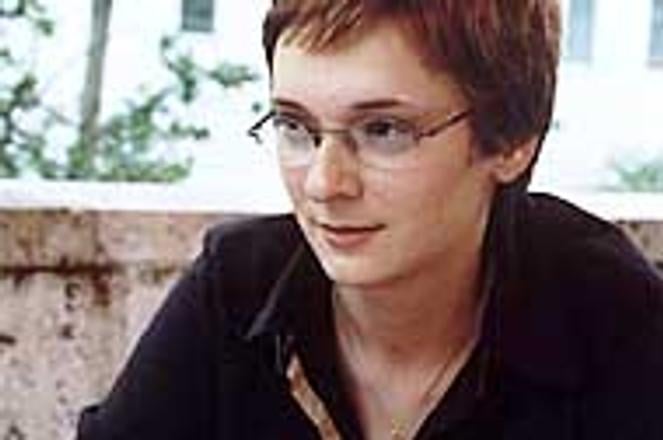UROBOROS deputy chair Mária Turanská speaks about plaque placement (inset).photo: Ján Svrček
PLANS to lay a memorial plaque calling for religious tolerance on the 400th anniversary of the burning of the first known Bratislava witch, Agáta Toot Borlobaschinová, may fail due to opposition from the Bratislava Regional Conservation Office (KPÚ).
The civic association Spoločnosť Uroboros had intended to hold a meeting in the city centre on May 24 to light candles in memory of Borlobaschin, who was condemned to the stake for allegedly communing with a devil named Peen. The group had also wanted to fix a bronze plaque to the pavement at the corner of Michalská Street and Hurbanovo Square in the downtown core.
But the conservation authority has said that the plaque would highlight a period of the city's history which was not characteristic of Bratislava. Its refusal to support the project came as a surprise to Uroboros, especially after Bratislava Old Town City Council, the Bratislava Town Hall's construction section, the Slovak Historical Society and the Slovak Academy of Sciences okayed the project.
Approval from all five bodies is needed to mount such plaques.
In defence of his office's stance, KPÚ head Marián Havlík said the plaque was "unsuitable from the socio-ideological point of view, because it stresses an episode of the city's history which has little significance and is being taken out of context".
Borlobaschin, who died at a stake erected midway between today's Župné and Hurbanovo squares on May 24, 1602, was tortured and forced to admit to communing with a devil, flying on a broom, and blinding a woman by sewing shut the eye of a toad.
Havlík refused further comment on his decision, saying that only KPÚ Director Katarína Kosová was authorised to give statements to the media.
Kosová, however, said that she could not provide an official statement until the results of an appeal by Uroboros are known.
Uroboros submitted the appeal to the KPÚ on May 14, hoping that it would be decided within 15 days.
Historical sources confirm Havlík's statement that Bratislava was not the centre for witch hunting in the Middle Ages on Slovak territory (see related article, this page).
But Uroboros vice-chair Mária Turanská argued that her group did not want to paint Bratislava as a persecutor of witches, rather to stress the need for tolerance. She said the plaque was intended as a warning that even in the 21st century, many people still faced discrimination for their religion, lifestyle or race.
"The commemoration is not a glorification of this particular person, but rather an appeal to strengthen tolerance among people, religions, races and cultures," Turanská said, adding that her group saw the witch as a symbol of what can happen as a result of religious fanaticism.
Whatever the outcome of the appeal, Turanská said, Uroboros will meet on May 24 in the late afternoon to light candles, and will ask the owner of the nearby Café Regina restaurant to hang the plaque temporarily in its front window.
The 40-by-75 centimetre (15-by-30 inch) bronze relief plaque was designed by local sculptor Ľudmila Cvengrošová. Turanská said it portrayed part of the historical area in front of Michalská Gate and a woman burning at the stake in the background. The inscription, in Slovak and English, says "In commemoration of the first witch burned in Bratislava."
"We wanted to make the plaque attractive and legible for tourists who visit the city," Turanská said.
Vladimír Segeš, a historian and editor in chief of the História magazine, said he could not understand why the KPÚ opposed the plate.
"I don't understand why the KPÚ was against the project, and to be honest, I didn't understand the arguments they presented. What is a socio-ideological point of view anyway?"
Segeš prepared the Slovak Historical Society's approving stance on the project.
"We need to uncover our history, whether it's nice or not. This particular period was a sad one but we can't delete it. The Inquisition was a general phenomenon across Europe in the Middle Ages, and so were burnings at stakes. We can't pretend that it didn't exist here," Segeš said.


